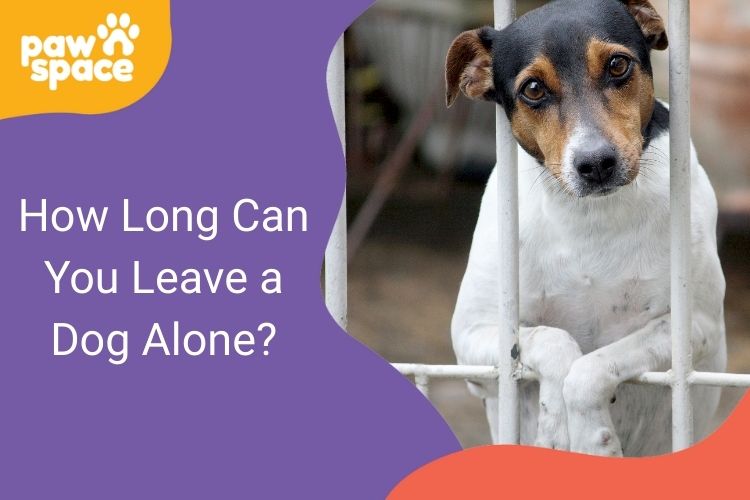How Long Can You Leave a Dog Alone? Leaving your dog behind is sometimes necessary, but for how long is too long? This guide discusses how age, breed, health, and temperament influence your dog’s tolerance for being left alone. Discover expert-recommended limits of time, learn convenient solutions for working pet parents, signs of distress, and advice on how to keep your dog safe and content when you’re away.
Table of Contents
Toggle- Introduction
- How Long Can You Leave a Dog Alone?
- 1. Age and Developmental Stage
- 2. Breed and Temperament
- 3. Physical and Emotional Needs
- 4. How to Make Alone Time Smoother
- 5. Special Considerations
- Pawspace: The safe space for your pets
- Why Choose Pawspace?
- Conclusion
- FAQs
- 1. Is it alright to leave my dog alone for 8 hours when I work?
- 2. For how long can a puppy be left behind?
- 3. Can I leave my dog alone at home at night?
- 4. How can I tell if my dog is lonely or stressed?
- 5. What can I do if my dog doesn’t want to be left alone?
Introduction
Dogs are social creatures who thrive on routine, love, and attention. But modern life seems to force us to leave them behind for hours at a stretch, for work, housework, or social engagements. While dogs can tolerate some solitude, prolonged separation can lead to boredom, stress, and even bad behavior. So how long does it take to be away from your dog?
The answer relies on a plethora of variables: your dog’s age, health, breed, training, and temperament, and their health. In this blow, we’ll explore how long can dogs be left alone, what to look for, and how to make their alone time comfortable and engaging.

How Long Can You Leave a Dog Alone?
1. Age and Developmental Stage
Puppies (Under 6 Months) Puppies are tiny bladders with huge emotional requirements. On average, they can hold it for approximately an hour per month of age. A 3-month-old puppy should therefore not be left for over 3 hours. They equally require frequent feeding, socialisation, and constant supervision to avoid accidents and destruction.
- Teen Dogs (6-18 Months)
Teenage dogs can tolerate longer absence from the owner but still need structure and stimulation. Solo time can be limited to 4–5 hours, and they need to be provided with toys, water, and a safe place. This is also an extremely crucial training and teaching good habits phase.
- Adult Dogs (18 Months-7 Years)
Well-adjusted healthy adult dogs can usually be left alone for 6–8 hours. They do not necessarily need to be left alone that long daily, however. Dogs are pack animals and need interaction, exercise, and mental stimulation during the day.
- Senior Dogs (7+ Years)
Older dogs need more frequent outings outside and can find hours left alone stressful or unhealthy. 4-6 hours maximum, based on their mobility and medical requirements.
2. Breed and Temperament
Some breeds are more independent and strong in solitude, and some are extremely social and prone to separation anxiety.
- Independent breeds such as Basset Hounds, Shiba Inus, and Chow Chows actually prefer just being alone by themselves.
- High-maintenance or social breeds such as Border Collies, Golden Retrievers, and Labradors require more stimulation and attention.
- Velcro dogs, the ones that attach to people, can have trouble with even temporary separations.
Temperament plays a part, too. There are some dogs that are naturally laid-back and self-comforting, and there are some that get distressed or destructive when left alone. Get to know your dog’s personality to determine how long he can be left without upsetting him.
3. Physical and Emotional Needs
Dogs need more than food and water they need:
- Bathroom breaks: All adult dogs must potty every 6–8 hours. Puppies and older dogs might need to go more often.
- Exercise: Inadequate physical exercise can cause boredom, obesity, and problems with behavior.
- Mental stimulation: Dogs left alone with nothing to stimulate their minds or keep them occupied will get anxious or destructive.
- Social interaction: Dogs are pack animals and social and need companionship. Left alone for an extended period will cause depression or separation anxiety.
If your pet is alone for an extended period, they will exhibit distress-like behavior such as:
- Excessive barking or howling
- Chewing on furniture or digging
- Soiling the house
- Pacing or restlessness
- Withdrawal or lethargy
4. How to Make Alone Time Smoother
If you must leave your dog home alone on a regular basis, these tips will make it easier on both of you:
- Create a Routine
Routine is preferred by dogs. Feed, walk, and leave at the same times daily in order to minimize anxiety.
- Exercise Prior to Leaving
A relaxed dog is an exhausted dog. A quick walk or playtime prior to leaving can burn off excess energy and calm restlessness.
- Utilise Enrichment Toys
Puzzle toys, treat toys, and chew toys can occupy your dog’s mind when you are away.
- Provide a Safe Place
It could be a crate, a room with a gate across it, or a quiet space, but provide your dog with a place they can call their own where they feel safe.
- Leave Background Noise
A radio or TV left in the background on low will provide a soothing background noise and stave off loneliness.
- Hire a Pet Sitter or Dog Walker
If you are out for more than 6 hours, think about hiring someone to take your dog out for a break, walk, or playtime.
- Attempt Doggy Daycare
Even occasionally or at the weekends can provide worthwhile socialisation and stimulation for dogs who don’t do well left alone.
- Utilise a Pet Camera
Remote viewing of your dog can enable you to gain an understanding of their behavior and make appropriate adjustments if necessary.
5. Special Considerations
- Separation Anxiety
Certain dogs get extremely upset being left behind. They are destructive, bark, and even injure themselves. If your dog has separation anxiety, seek out a vet or a certified trainer for a behavior modification class.
- Medical Conditions
Diabetic, incontinence, and other medical conditions may require special consideration. Always check with your vet before leaving medical-condition dogs home alone for periods of time.
- Multiple Dogs
Having a companion dog is a bless-ing, but no guarantee. Some companion dogs will even get anxious or fight if they are left together. Observe them interacting first before assuming they’ll keep company with one another.
Pawspace: The safe space for your pets
We at Pawspace are dedicated to providing top-notch care and companionship for your
beloved pets. Honoured to be India’s biggest pet-centred community! Created and curated by pet parents.
Our services include pet grooming, pet boarding, pet sitting, doorstep dog training, dog walking, pet taxi/cab, pet relocation, pet funeral, cat grooming, etc.
Why Choose Pawspace?
- Available on demand for pet parents everywhere
- Verified caregivers with a 5-point checklist & rigorous background checks
- Be at peace by receiving regular updates through chats, photos and videos
Conclusion
So for how long can you leave a dog on its own? It depends on your dog’s age, breed, health, and temperament, but 4-6 hours is often the magic number for a normal adult dog. Puppies, seniors, and special-needs dogs need more. The trick is to know your dog’s unique needs and provide them with enrichment, structure, and care even when you’re away.
With good planning and the correct help, you are able to divide your schedule and your dog’s needs. Remember, a happy, relaxed dog equals a happier, more relaxed pet parent too.
FAQs
1. Is it alright to leave my dog alone for 8 hours when I work?
Yes, the majority of adult dogs can cope with 6-8 hours on their own, but providing a mid-day break through the agency of a dog walker, pet sitter, or friend is best.
2. For how long can a puppy be left behind?
Puppies can be left behind for one hour for every month of age. The 4-month-old puppy should not be left for more than 4 hours.
3. Can I leave my dog alone at home at night?
Occasionally, yes. But only if your dog is healthy, has water, and has experience being alone. For extended trips, pet sit or board.
4. How can I tell if my dog is lonely or stressed?
Signs are house soiling, pacing, destructiveness, or excessive barking. A pet camera allows you to monitor their routines when you are not home.
5. What can I do if my dog doesn’t want to be left alone?
Desensitisation, crate training, interactive toys, and professional training are useful. More severe problems might require a behaviorist or visit to a vet.

















